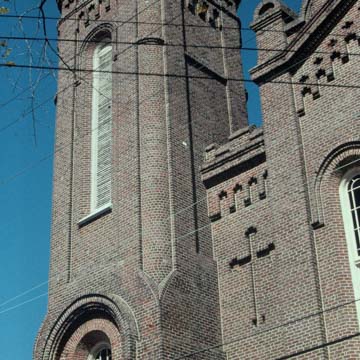The Redemptorists, who came to New Orleans from Baltimore in 1847, commissioned Henry Howard, then in partnership with Dresden-born Albert Diettel (1824–1896), who had arrived in New Orleans in 1849, to build this church for a mainly Irish Catholic congregation. Exploiting fully the sculptural potential of brick construction, the architects employed brick hood moldings with curved profiles to outline the round-arched windows and manipulated brick into elaborate corbels and moldings and a shaped parapet. Two substantial towers, one square and the other octagonal, squeeze the facade between them. The towers are of different heights; the taller was originally even higher than at present. A fire in 1911 caused the loss of the taller tower’s spire, and it was then lowered twenty-five feet in 1934 when its weight caused it to sag. The sloping courses of brick at the tower’s outer corner reveal the problem, and the tower leans slightly to the left front. Inside the church, a flattened barrel vault and attached columns between the arches of the nave arcade establish a smooth rhythm toward the altar. The stained glass windows featuring religious figures were made in 1908 by Flanagan and Biedenweg of Chicago. The adjacent school, designed in 1899 by New Orleans architect Allison Owen (1869–1951) of Diboll and Owen (Collins C. Diboll, 1868–1936), repeats the narrow vertical forms of the church. The Archdiocese of New Orleans closed the church in 2001, and the building and its adjacent school are being converted (2017) into a hotel and event venue.
You are here
Historic Sts. Peter and Paul Church
If SAH Archipedia has been useful to you, please consider supporting it.
SAH Archipedia tells the story of the United States through its buildings, landscapes, and cities. This freely available resource empowers the public with authoritative knowledge that deepens their understanding and appreciation of the built environment. But the Society of Architectural Historians, which created SAH Archipedia with University of Virginia Press, needs your support to maintain the high-caliber research, writing, photography, cartography, editing, design, and programming that make SAH Archipedia a trusted online resource available to all who value the history of place, heritage tourism, and learning.











